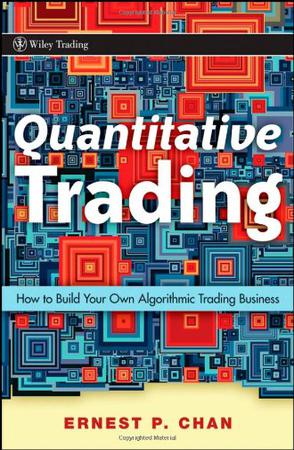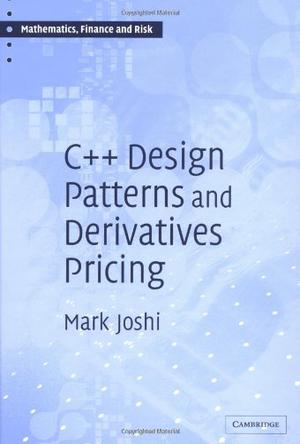-

Interest Rate Models - Theory and Practice
-

Quantitative Trading
By some estimates, quantitative (or algorithmic) trading now accounts for over one-third of trading volume in the United States. While institutional traders continue to implement this highly effective approach, many independent traders—with limited resources and less computing power—have wondered if they can still challenge powerful industry professionals at their own game? The answer is "yes," and in Quantitative Trading, author Dr. Ernest Chan, a respected independent trader and consultant, will show you how. Whether you're an independent "retail" trader looking to start your own quantitative trading business or an individual who aspires to work as a quantitative trader at a major financial institution, this practical guide contains the information you need to succeed. Organized around the steps you should take to start trading quantitatively, this book skillfully addresses how to: * Find a viable trading strategy that you're both comfortable with and confident in * Backtest your strategy—with MATLAB®, Excel, and other platforms—to ensure good historical performance * Build and implement an automated trading system to execute your strategy * Scale up or wind down your strategies depending on their real-world profitability * Manage the money and risks involved in holding positions generated by your strategy * Incorporate advanced concepts that most professionals use into your everyday trading activities * And much more While Dr. Chan takes the time to outline the essential aspects of turning quantitative trading strategies into profits, he doesn't get into overly theoretical or sophisticated theories. Instead, he highlights the simple tools and techniques you can use to gain a much-needed edge over today's institutional traders. And for those who want to keep up with the latest news, ideas, and trends in quantitative trading, you're welcome to visit Dr. Chan's blog, epchan.blogspot.com, as well as his premium content Web site, epchan.com/subscriptions, which you'll have free access to with purchase of this book. As an independent trader, you're free from the con-straints found in today's institutional environment—and as long as you adhere to the discipline of quantitative trading, you can achieve significant returns. With this reliable resource as your guide, you'll quickly discover what it takes to make it in such a dynamic and demanding field. -

Quantitative Trading
By some estimates, quantitative (or algorithmic) trading now accounts for over one-third of trading volume in the United States. While institutional traders continue to implement this highly effective approach, many independent traders—with limited resources and less computing power—have wondered if they can still challenge powerful industry professionals at their own game? The answer is "yes," and in Quantitative Trading, author Dr. Ernest Chan, a respected independent trader and consultant, will show you how. Whether you're an independent "retail" trader looking to start your own quantitative trading business or an individual who aspires to work as a quantitative trader at a major financial institution, this practical guide contains the information you need to succeed. Organized around the steps you should take to start trading quantitatively, this book skillfully addresses how to: * Find a viable trading strategy that you're both comfortable with and confident in * Backtest your strategy—with MATLAB®, Excel, and other platforms—to ensure good historical performance * Build and implement an automated trading system to execute your strategy * Scale up or wind down your strategies depending on their real-world profitability * Manage the money and risks involved in holding positions generated by your strategy * Incorporate advanced concepts that most professionals use into your everyday trading activities * And much more While Dr. Chan takes the time to outline the essential aspects of turning quantitative trading strategies into profits, he doesn't get into overly theoretical or sophisticated theories. Instead, he highlights the simple tools and techniques you can use to gain a much-needed edge over today's institutional traders. And for those who want to keep up with the latest news, ideas, and trends in quantitative trading, you're welcome to visit Dr. Chan's blog, epchan.blogspot.com, as well as his premium content Web site, epchan.com/subscriptions, which you'll have free access to with purchase of this book. As an independent trader, you're free from the con-straints found in today's institutional environment—and as long as you adhere to the discipline of quantitative trading, you can achieve significant returns. With this reliable resource as your guide, you'll quickly discover what it takes to make it in such a dynamic and demanding field. -

Financial Calculus
The rewards and dangers of speculating in the modern financial markets have come to the fore in recent times with the collapse of banks and bankruptcies of public corporations as a direct result of ill-judged investment. At the same time, individuals are paid huge sums to use their mathematical skills to make well-judged investment decisions. Here now is the first rigorous and accessible account of the mathematics behind the pricing, construction and hedging of derivative securities. Key concepts such as martingales, change of measure, and the Heath-Jarrow-Morton model are described with mathematical precision in a style tailored for market practitioners. Starting from discrete-time hedging on binary trees, continuous-time stock models (including Black-Scholes) are developed. Practicalities are stressed, including examples from stock, currency and interest rate markets, all accompanied by graphical illustrations with realistic data. A full glossary of probabilistic and financial terms is provided. This unique, modern and up-to-date book will be an essential purchase for market practitioners, quantitative analysts, and derivatives traders, whether existing or trainees, in investment banks in the major financial centres throughout the world. -

C++ Design Patterns and Derivatives Pricing
-

Arbitrage Theory in Continuous Time
The third edition of this popular introduction to the classical underpinnings of the mathematics behind finance continues to combine sound mathematical principles with economic applications. Concentrating on the probabilistic theory of continuous arbitrage pricing of financial derivatives, including stochastic optimal control theory and Merton's fund separation theory, the book is designed for graduate students and combines necessary mathematical background with a solid economic focus. It includes a solved example for every new technique presented, contains numerous exercises, and suggests further reading in each chapter. In this substantially extended new edition Bjork has added separate and complete chapters on the martingale approach to optimal investment problems, optimal stopping theory with applications to American options, and positive interest models and their connection to potential theory and stochastic discount factors. More advanced areas of study are clearly marked to help students and teachers use the book as it suits their needs.